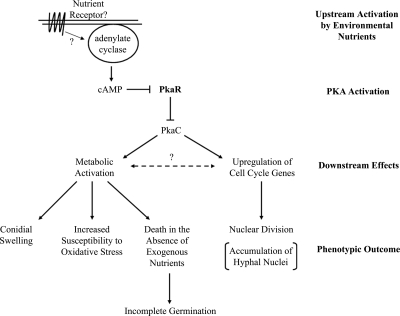FIG. 6.
Summary. Upstream activation: a resting conidium senses environmental nutrients by an unknown signaling mechanism, ultimately leading to activation of adenylate cyclase and production of cAMP. PKA activation: binding of cAMP to PkaR leads to release and activation of PKA catalytic subunits. Downstream effects: phosphorylation of downstream targets leads to metabolic and cell cycle activation. Phenotypic outcome: metabolic activation leads to swelling and increased susceptibility to oxidative stress. In a ΔpkaR mutant, PKA is constitutively active, leading to these phenotypes in the absence of an extracellular trigger (i.e., nutrients). Also, in the mutant unregulated nuclear division leads to an increased accumulation of hyphal nuclei. It is possible that PKA lies upstream of only one branch, while an unknown pathway connects the two (dashed line).

